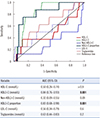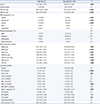Abstract
Background
Methods
Results
Figures and Tables
Fig. 1
Box-and-whisker plots for the distribution of HDL-C (A), HDL3-C (B), non-HDL3-C (C), and HDL3-C proportion (D) stratified by the number of MetS components (0, N=201; 1, N=78; 2, N=13; and 3, N=8). HDL3-C levels and HDL3-C proportion were significantly higher in the three MetS component group than in the other groups (P<0.05, Kruskal-Wallis test with post-hoc Dunn test; P with statistical significance is indicated). The central box represents the values from the lower to upper quartile (25–75 percentile). The middle line represents the median. The vertical line extends from the minimum to the maximum value.

Fig. 2
Receiver operator characteristic curves of lipid profiles for predicting MetS in individuals with high HDL-C levels (≥2.331 mmol/L). HDL3-C levels and HDL3-C proportion were significant (P=0.001) and comparable (P=0.9) for predicting MetS.

Table 1
Characteristics of the study population

Values are expressed as median (interquartile range), number (percentage), or proportion.
P is based on the comparison between men and women using the Mann-Whitney U test (quantitative variables) and Chi-square or Fisher's exact test (categorical variables); bold text indicates P<0.05.
*Treated with single calcium channel blockers (N=4), single angiotensin II receptor blockers (N=2), calcium channel blockers with angiotensin II receptor blockers (N=2), or lifestyle modification only (N=3).
†Treated with sitagliptin (N=1) or lifestyle modification only (N=1).
‡Treated with atorvastatin (N=6), rosuvastatin (N=3), pitavastatin (N=2), or lifestyle modification only (N=4).
Abbreviations: SBP, systolic blood pressure; DBP, diastolic blood pressure; BMI, body mass index; VFA, visceral fat area; Hb, hemoglobin; FPG, fasting plasma glucose; HbA1C, glycated hemoglobin; Total-C, total cholesterol; LDL-C, low-density lipoprotein cholesterol; HDL-C, high-density lipoprotein cholesterol; HDL3C, high-density lipoprotein 3 cholesterol; TG, triglycerides; AST, aspartate transaminase; ALT, alanine transaminase; GFR, glomerular filtration rate based on the Modification of Diet in Renal Disease Study equation.
Table 2
Correlations between HDL subclass and parameters reflecting metabolic syndrome components or lipid profiles

Table 3
Comparison between the two groups with and without metabolic syndrome (MetS)

Values are expressed as median (inter-quartile range) or number (percentage).
Bold text indicates P<0.05.
*National Cholesterol Education Program Adult Treatment Panel III with Asian modification: (1) abdominal obesity: waist circumference ≥90 cm (men) or ≥80 cm (women) in Asian individuals; (2) blood pressure ≥130/85 mm Hg or medication; (3) fasting glucose ≥5.55 mmol/L or drug treatment; (4) HDL-C <1.036 mmol/L (men) or <1.295 mmol/L (women) or drug treatment; (5) TG ≥1.695 mmol/L or drug treatment [2324].
†Data was available for 294 subjects. Adequate is defined as one standard drink (14 g of ethanol, as found in five ounces of wine or 12 ounces of beer) per day or seven standard drinks per week with no more than three drinks per occasion. Heavy alcohol use is defined as binge drinking (four drinks for women and five drinks for men) on five or more days in the past month [31]. There was a weak positive correlation with alcohol grade vs HDL3-C (r=0.13, P=0.03), but not with HDL-C (r=0.04, P=0.5; data not shown).
Abbreviations: see Table 1.




 PDF
PDF ePub
ePub Citation
Citation Print
Print



 XML Download
XML Download